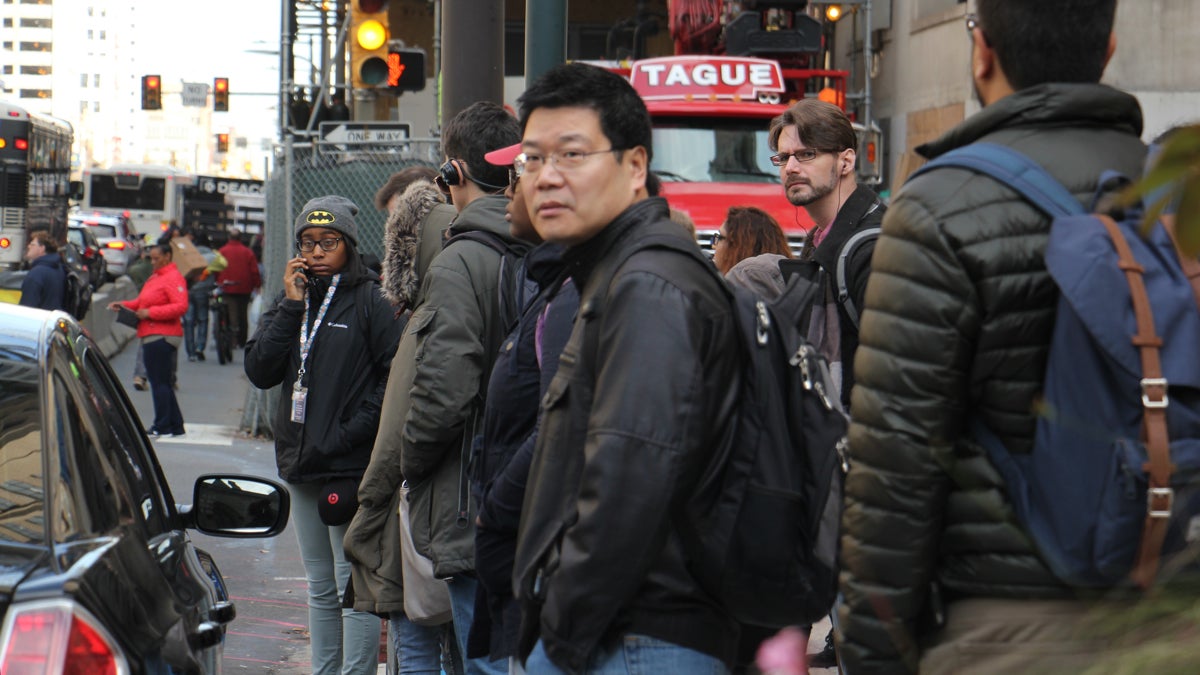From cars to shuttles, hospitals and health care workers navigate SEPTA strike
Listen
Temple University employees and students wait at Broad and Arch streets for a bus provided by the university. (Emma Lee/WHYY)
With Philadelphia’s transit strike putting a strain on people trying to get around the city, many hospitals have added special shuttles and more parking options for patients and employees.
“It’s been busy, a lot of Drexel, Penn employees and staff,” said Mike Savigliano, who had been driving one of those vehicles around all Wednesday morning.
Temple University Hospital has been offering staff discounted parking in its garages.
When disruptions such as a papal visit, a massive snowstorm or a SEPTA strike shut down most mass transit in the city, the Hospital System of Southeastern Pennsylvania’s health care desk kicks in. Inside the city’s Emergency Operations Center, Mark Ross has been coordinating real-time communication between hospitals.
“You know, for hospitals and health care, things are going pretty well, we’ve known this was a potential,” he said of the strike on the second day of the work stoppage.
Ross likened the situation to prepping for a snowstorm with access to facilities as the focus of his energy. No major issues have been reported and hospitals are fully operational, he said, but he is remaining alert.
“You know, [Tuesday] night with the disruption to regional rail, and workers that couldn’t get in for that 7 p.m. shift change, we were working very closely with hospitals to make sure … were their shuttles able to get out and get the people; what did the staffing levels look like; how could we interact with city agencies to ensure we got the staff into the agencies; if it was critical.”
Although many commuters have been putting in extra time to get to their destinations, it can still be a struggle.
Over by the Hospital of the University of Pennsylvania, medical assistant Katrina Smith was running late Wednesday morning.
“I waited for the van for an hour,” she said. “And it was full, and it was the last one.”
Still, she was able to figure out another route to get to work from West Philadelphia — regional transit and a different shuttle.
Others have been opting for ride-hailing services or cabs.
Ross, the emergency preparedness manager for the region’s hospital association, said he was not aware of any large-scale changes to appointments.
Meanwhile, a spokesman said Jefferson Health has experienced an uptick in traffic on its “tele-health” service for patients to talk to their doctor from home instead.
And Terrence Swartz took matters into his own hands — or feet. On his way Wednesday to see a niece who’d been hospitalized at the Children’s Hospital of Philadelphia, he just decided to walk.
“Long as I got two feet, I’m happy, but overall it’s tiresome,” he said of the 45-minute walk. “I had no other choice, if I had to go to work and visit my niece.”
WHYY is your source for fact-based, in-depth journalism and information. As a nonprofit organization, we rely on financial support from readers like you. Please give today.

